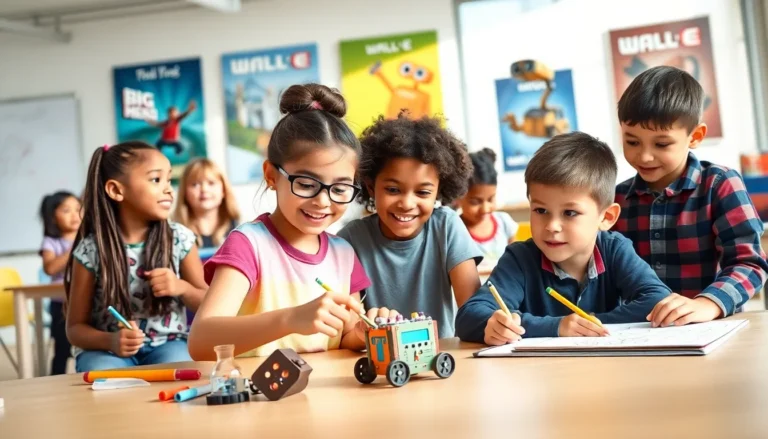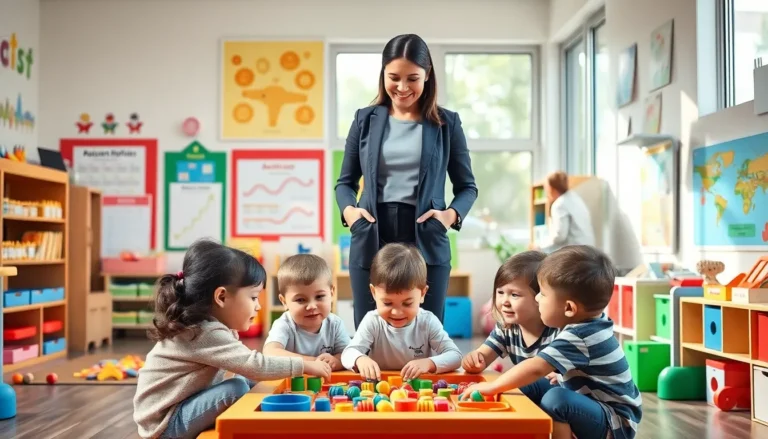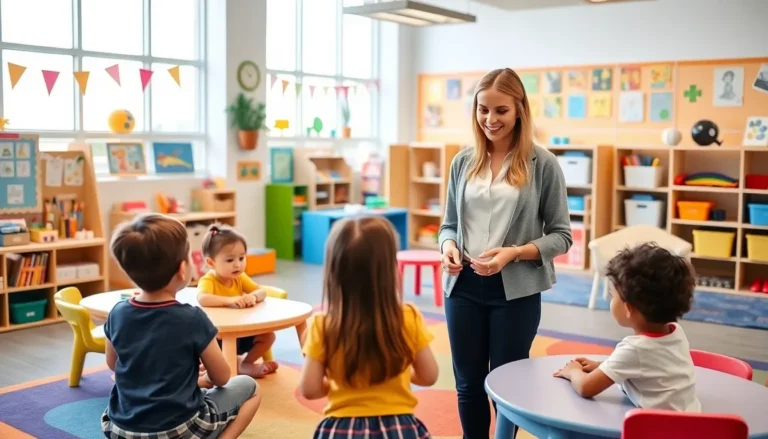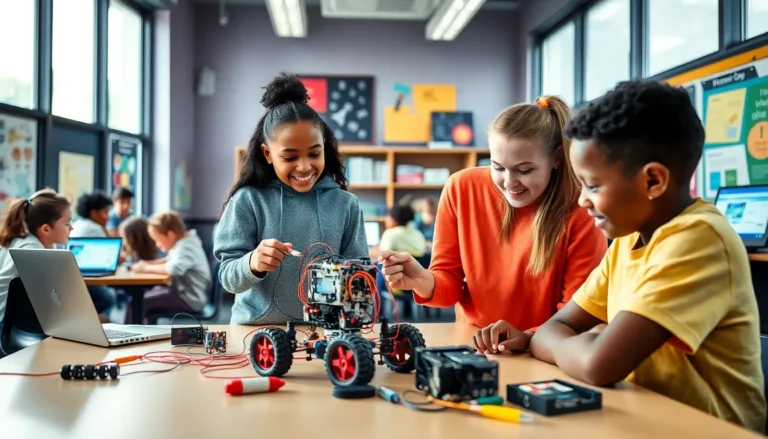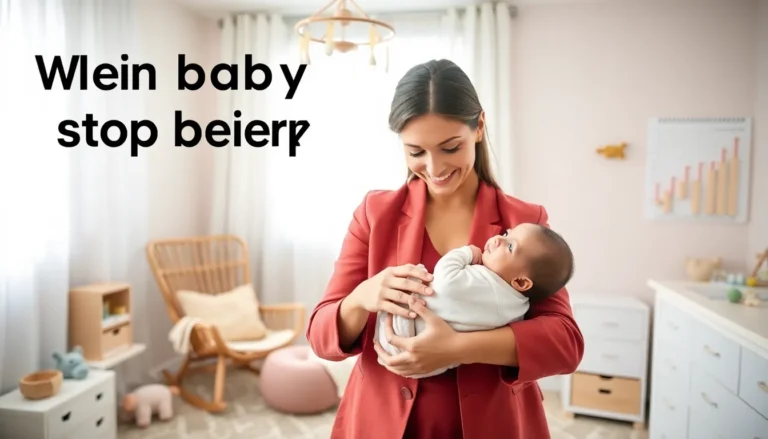Table of Contents
ToggleFrom the moment a baby enters the world, their eyes become a window to their developing mind. Eye contact plays a crucial role in early communication, fostering connections between infants and their caregivers. This simple yet powerful interaction not only helps in bonding but also lays the foundation for social and emotional development.
As babies gaze into the eyes of their parents, they begin to understand trust and affection. Those fleeting moments of eye contact can spark joy, curiosity, and even laughter. Understanding the significance of these interactions can help parents nurture their child’s growth, ensuring they thrive emotionally and socially. Exploring the nuances of baby eye contact reveals the profound impact it has on early relationships and overall development.
Understanding Baby Eye Contact
Eye contact plays a crucial role in the early life of a baby, facilitating communication and strengthening connections with caregivers. These interactions significantly contribute to emotional and social development.
The Importance of Eye Contact in Infants
Eye contact establishes initial communication between infants and caregivers. Infants may respond to engaging faces within weeks of birth, demonstrating recognition and interest. This exchange fosters emotional bonds, enhancing feelings of security and attachment. Enhanced eye contact can stimulate brain development, promoting social skills as the child grows. As caregivers respond to an infant’s gaze, they validate the child’s efforts to communicate, reinforcing trust and affection.
Developmental Milestones Related to Eye Contact
Eye contact evolves through specific developmental milestones.
- Newborns (0-2 months): Eye contact is sporadic; babies recognize faces and engage with caregivers through gazing.
- Two to Three Months: Infants enhance focus and begin to reciprocate gaze, indicating developing social skills.
- Four to Six Months: Babies increasingly seek eye contact, engaging in joyful interactions, and responding through smiles.
- Seven to Nine Months: Eye contact becomes more intentional; children may use it to gain attention or convey needs.
- Ten to Twelve Months: Infants use eye contact as a social tool, indicating shared experiences and emotions.
Tracking these milestones helps caregivers understand and support their child’s emotional and social development effectively.
Factors Influencing Baby Eye Contact


Several factors influence the development of eye contact in babies, impacting their ability to connect with caregivers. Understanding these factors enhances awareness of how environmental and parental elements contribute to a child’s social and emotional growth.
Environmental Factors
Environmental factors play a significant role in eye contact development.
- Lighting: Adequate lighting enhances visibility, making it easier for infants to focus on faces.
- Distractions: A cluttered or noisy environment can hinder a baby’s ability to engage in eye contact, reducing effective communication.
- Proximity: Closer physical distance facilitates better eye contact, allowing infants to connect with their caregivers more easily.
- Social Interaction: Engaging in social settings with other people encourages babies to observe and imitate eye contact behaviors.
Creating a nurturing environment promotes healthy eye contact development, helping babies foster connections with their caregivers.
Parental Influence
Parental influence significantly shapes a baby’s ability to establish eye contact.
- Response to Gaze: Caregivers who respond positively to an infant’s gaze encourage more frequent interactions.
- Facial Expressions: Parents who use expressive faces stimulate eye contact and emotional engagement.
- Eye Level Engagement: Interacting at the baby’s eye level fosters connection, as it allows the child to better focus and engage.
- Quality of Interactions: Regular, warm interactions promote comfort, leading to more sustained eye contact as the baby develops.
Active parental participation creates a supportive framework that enhances eye contact skills in infants, crucial for emotional and social development.
Benefits of Engaging in Eye Contact
Engaging in eye contact offers significant benefits for both infants and their caregivers. These benefits encompass emotional bonding and cognitive development, each playing a critical role in a child’s growth.
Emotional Bonding
Emotional bonding is strengthened through eye contact. When caregivers maintain eye contact with their babies, they communicate love, security, and trust. Babies respond by developing a sense of attachment, which fosters emotional security. Research demonstrates that consistent eye contact during interactions enhances the parent-child connection. This interaction helps infants express feelings like happiness and comfort, promoting healthy emotional development.
Cognitive Development
Cognitive development significantly benefits from eye contact. Through these interactions, infants learn to process social cues and recognize emotional expressions. Eye contact facilitates understanding of nonverbal communication, allowing babies to build social skills. Studies indicate that engaging in eye contact at early stages enhances language acquisition and problem-solving abilities. As babies learn to associate actions and words with visual stimuli, their cognitive skills expand, laying a foundation for future learning.
Common Concerns About Baby Eye Contact
Concerns about baby eye contact often arise as caregivers observe their child’s development. Understanding these concerns helps in recognizing normal variations and identifying potential issues.
Lack of Eye Contact in Developmental Disorders
Lack of eye contact may signal developmental disorders, such as autism spectrum disorder (ASD) or visual impairments. Children with ASD often display reduced eye contact, impacting social interaction and communication. Early recognition is crucial since it allows for timely intervention. Effective screening tools and assessments can help determine whether a child’s eye contact patterns align with typical developmental milestones. Caregivers should be aware that some infants may develop social referencing and eye contact skills at a different pace, depending on individual factors.
When to Seek Professional Advice
Seeking professional advice becomes important when concerns about a child’s eye contact persist beyond typical developmental ranges. If a baby shows limited or inconsistent eye contact after six months, caregivers should consult a pediatrician or child development specialist. Identification of concurrent behaviors—such as delayed speech or lack of interest in social engagement—may also warrant further evaluation. Professional guidance can provide strategies for enhancing communication skills and addressing possible developmental issues comprehensively.

